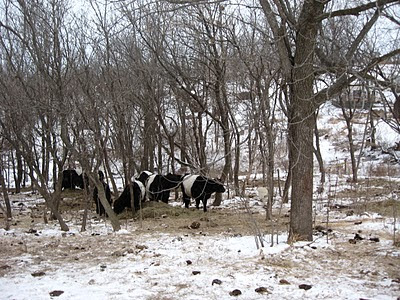Lesson three, Janice and Hazel look after bottle lambs
This winter has highlighted several deficiencies around here. One being the lack of handling facilities and winter sheep lots. We had lots of trouble keeping sheep on our farm before we took electric net and layered it up against our high tensile exterior fence. The other problem we have been having is that the calves are not intimidated by the net in the winter. Frozen ground is not as good an electrical ground, so cattle on frozen ground do not receive much of a shock from the electric net. Hence the calves have been stepping over it and getting into the hay storage and the sheep area.
I spy with my little eye: calves in the sheep shelter... darn you calves
In other news, we have continued to clear trees (you can catch a glimpse of it in the upper left corner of the above picture). We were selected to be part of the Practical Farmers of Iowa (PFI) Savings Incentive Program (SIP) and so I have opened the special savings account to begin saving for this program. These funds will likely get put toward a larger sheep hoop building that can house the sheep in the winter and finish out feeder pigs while the sheep are out at pasture. Janice, Hazel, and I went to the Practical Farmers of Iowa Beginning Farmer Workshop this past weekend to work on our farm business plan, which is a requirement for SIP. We will be going to the Premier One Winter Sheep Day next weekend to look at their handling facilities and to examine their building layouts. To conclude this month on a somewhat humorous note:
Do you see something wrong in this picture?
No? How about now?
Our young ram Aegis had his head stuck again in the hay feeder. This morning was the third day in a row he got stuck. The first time I just cut out a tine (I was running late to a meeting), the second time I cut out as many tines as I could before the cutting wheel died, and the third time I cut out the last of the times. Now, every other tine has been removed from the old hog crate to make it easier for the the sheep to get to the hay and harder for the ram to get his head stuck.











